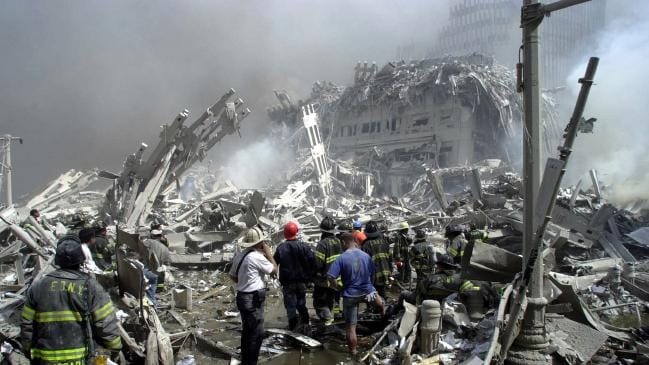
This article is more than
6 year old
The terror attacks on New York’s World Trade Centre on September 11, 2001 sent shockwaves across the world.
Thousands watched as the famous Twin Towers were sent crumbling to the ground after two planes crashed into the 110 storey buildings, killing 2977 people.
Following the attacks there was a lot of speculation about what exactly caused the buildings to fall so quickly after the initial impact.
RELATED: Photos show true horror of 9/11
RELATED: Aussie victim ‘predicted’ 9/11 attack
Multiple structure and design flaws of the buildings have been brought to light, but the sequence of events that led to the buildings collapsing like they did is still a hotly debated subject.
Two government reports produced slightly different findings on what ultimately brought down the Twin Towers.

The first report by the Federal Emergency Management Agency (FEMA) was completed in 2002 and the second by the National Institute of Standards and Technology (NIST) was finished in 2005.
Both of these reports focused on two main events: the initial impact of the planes and the fires that broke out afterwards.
The FEMA report claimed that the fire weakened the floor trusses of the building, resulting in the bolts connecting the external columns to collapse.
When this happened to one floor it set off a chain reaction for all the ones below and causing each floor to collapse on top of the next until the whole building was brought down.
The NIST report had similar findings, agreeing that the weakened floor trusses played a part in the collapse.
However, instead of bolts being pulled off, the report suggests the forced pulled the exterior columns inward, resulting in the buildings collapsing in on themselves.
‘THE FLOOR TRUSSES WERE FLIMSY’
Ronald O. Hamburger, a structural engineer who was investigating the 9/11 disaster, described the vulnerabilities of the buildings during a lecture at Stanford in December 2001.
“These buildings were incredibly strong, especially with respect to resisting dead loads and wind loads, but they also had a number of vulnerabilities,” he said.
Mr Hamburger was a member of the engineer team hired to assess the performance of the World Trade Centre following the disaster.
“The floor trusses were relatively flimsy. As the tower collapsed, the trusses just fell apart,” he said.
He noted that the towers were built using a novel tube frame system that was designed to resist powerful winds of up to 130km/h.

While the frames were resistant to wind, they were otherwise very weak and broke apart instantly upon impact.
During his speech, Mr Hamburger also noted the angle that the planes hit each tower and how that impacted their collapse.
The first plane hit the north tower at a 45 degree angle and damaged floors 92 to 95. Approximately 40 minutes later the second plane hit the south tower, impacting floors 78 to 84.
“I believe that the hijackers flew the aircraft into the lowest part of the buildings they had access to,” Mr Hamburger said.
“If there had been no nearby structures, they would have hit the towers lower.”
He added that he believed the pilots intentionally flew the planes at an angle in an attempt to cause as much destruction as possible.
Mr Hamburger also said the extreme heat from the fires that broke out caused the steel holding the buildings together to warp.
“The impact probably caused a failure of the fireproofing in the affected areas. We think that the fuel ignited several floors in the building,” he said.
“Steel is born of fire. As it’s reheated, it expands and loses its rigidity. Above 1,000 degrees Fahrenheit (538C), it loses a significant amount of its strength.”

NOT ENOUGH STAIRWELLS
Another design flaw that may have resulted in less people being able to escape was the small number of stairwells.
When the Twin Towers were starting to be constructed in 1968 a new building code had been issued in New York which meant the number of required stairwells was reduced.
As a result, there were only three stairwells in the centre of each tower which ran up the height of each building.
Two of the stairwells in each tower were just over a metre wide, while the third one was one metre and 42cm wide.
After the planes hit the towers the elevators no longer became a viable option for escape, forcing occupants to run to the nearest stairwell.
Getting to a stairwell itself was a harrowing task and for those that did manage to reach one of the three they were then faced with new challenges.
Some of the stairwells were dark, filled with smoke, covered in jet fuel and jam packed full of people trying to escape.
The narrow width of the stairwells also slowed down escape dramatically.
Those fleeing the building also encountered firefighters in full gear trying to go the opposite way to help those still trapped.
The 9/11 attacks resulted in experts examining what could have been done to prevent the issues faced by those trying to escape the buildings.
Since the attack, national building codes were updated to include requirements like providing an additional stairwell or a specially designed elevator built to still function in extreme situations.
Blast-resistant stair-shaft walls are also now required for high rises over 128 metres high and glow in the dark markings are required on all high rise buildings for people to follow if the lights fail.